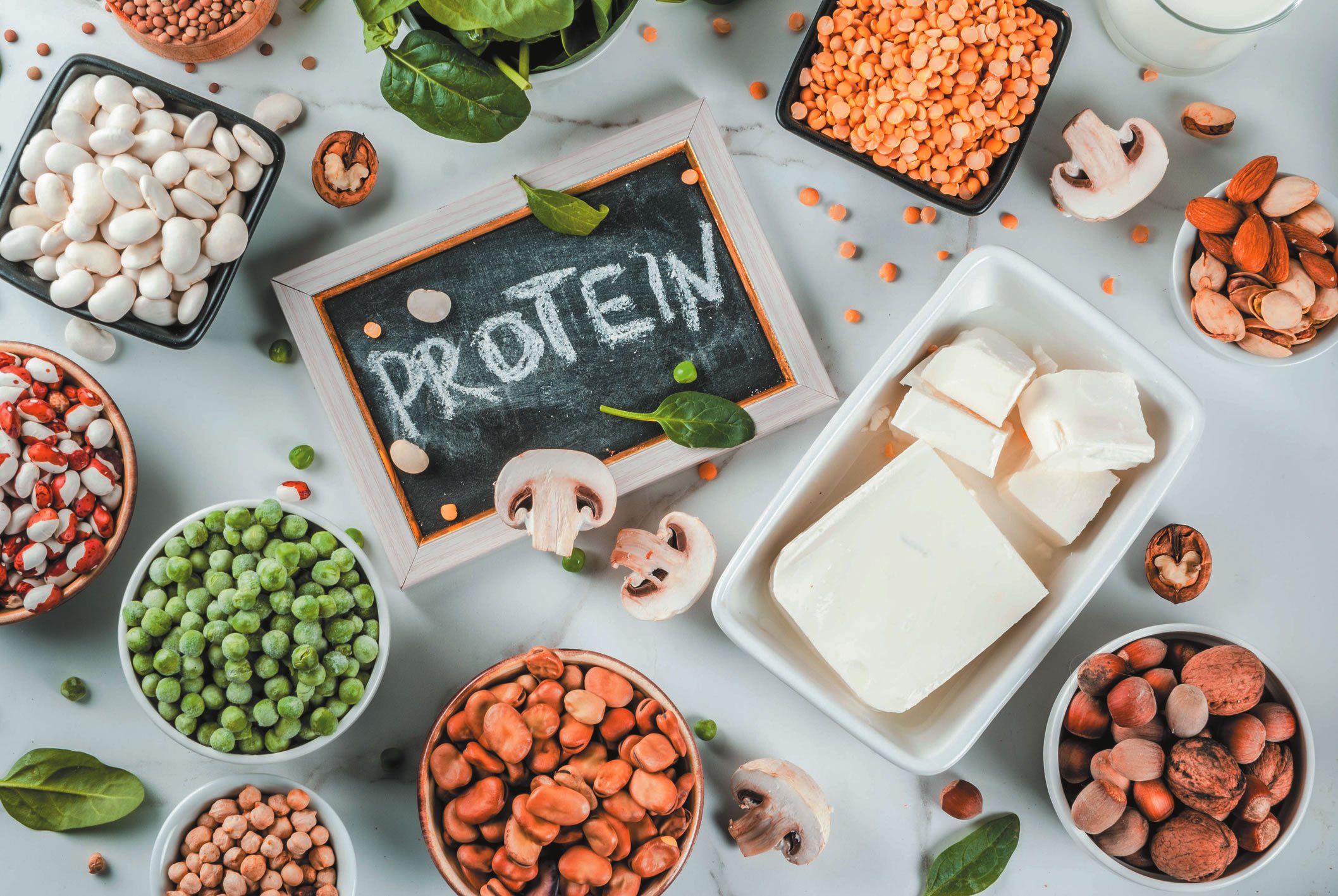
Protein quality
(From Wikipedia and other sources)
Protein quality is the digestibility and quantity of essential amino acids for providing the proteins in correct ratios for human consumption. There are various methods that rank the quality of different types of protein, some of which are outdated and no longer in use, or not considered as useful as they once were thought to be.
The current protein ranking standard in use is the Protein Digestibility Corrected Amino Acid Score (PDCAAS), which was recommended by Food and Agriculture Organization (FAO), and became the industry standard in 1993, and FAO has recently recommended the newer Digestible Indispensable Amino Acid Score (DIAAS) to supersede PDCAAS, due to the limitations of PDCAAS. While PDCAAS truncates all protein types that exceed the essential amino acid (EAA) requirements to 1.0, DIAAS allows a higher than 1.0 ranking, and as such, while for example both soy protein isolate and whey isolate are ranked 1.0 according to PDCAAS, in the DIAAS system, whey has a higher score than soy.
PDCAAS versus DIAAS
The main limitations of PDCAAS is that it doesn’t take into account anti-nutrient factors like phytic acid and trypsin inhibitors, which limit the absorption of protein among other nutrients. For this reason, DIAAS is promoted as the superior method and preferable over the PDCAAS. Other older methods like BV, PER, NPU and nitrogen balance may not reveal much about the amino acid profile and digestibility of the protein source in question, but can still be considered useful in that they determine other aspects of protein quality not taken into account by PDCAAS and DIAAS.
Protein ranking
Below follows a table that compares various proteins based on their rankings. Some of these results may differ and vary significantly depending on if it is soybeans or soy protein isolate, and so on. For example, while soybeans have a PDCAAS score of 0.91, many soy protein isolates (though not all) typically get a PDCAAS score of 1.0, and as such, is a complete protein. Likewise, the amino acid profile may differ from crop to crop depending on the soil, and between different breeds of soy. Generally speaking, however, soybeans rarely outperform whey protein isolate in PDCAAS rankings.
| Protein ranking methods and standards | ||||||||||
| Protein type | PER | NPU | BV | Protein Digestibility (PD) | Protein absorption rate | Amino Acid Score (AAS) | PDCAAS | DIAAS | Limiting amino acid | Complete protein? |
| Whey | 3.2 | 92% | 104 | N/A | 8-10 g/h | N/A | 1.0 | 1.09 | None | Yes |
| Casein | 2.5 | 85-92% | 77 | 95.1-97.6% | 6.1 g/h | 1.19 | 1.0 | None | Yes | |
| Egg | 3.9 | 94% | 100 | 97% | 1.3-2.8 g/h | N/A | 1.0 | None | Yes | |
| Beef | 2.9 | 73% | 80 | N/A | N/A | N/A | 0.92 | N/A | Tryptophan | No |
| Soy | 2.2 | 61% | 74 | 86% | 3.9 g/h | N/A | 0.91 | 0.898-0.906 | Meth+Cyst | Yes |
| Rice | N/A | N/A | N/A | N/A | N/A | 0.50 | Lysine | No | ||
| Pea | N/A | N/A | N/A | 2.4-3.4 g/h | 0.70 | Meth+Cyst | No | |||
| Hemp | N/A | N/A | 87 | 94.9% | N/A | 0.64 | 0.61 | Lysine | No | |
| Mycoprotein | N/A | N/A | N/A | 86% | N/A | N/A | 0.996 | Meth+Cyst | No | |
| Spirulina | 1.8-2.6 | 53-92% | 68 | 83-90% | N/A | N/A | None | Yes | ||
| Chlorella | N/A | N/A | N/A | N/A | N/A | N/A | Meth+Cyst | No | ||
Amino Acid profile
Below follows a table that compares the complete amino acid profiles of various proteins. The amino acid score is based on the prevalence of the essential amino acids and depends on if they reach sufficient quantity. PDCAAS scores do not take into account the quantity of the non-essential amino acids. The proteins deficient in an essential amino acid, are technically not complete proteins, but may still be considered as such if it is a slight deficiency in only one limiting amino acid (many vegan proteins are deficient in several EAAs).
*Semi-essential, under certain conditions
**Branched-chain amino acid (BCAA)
List of foods by protein content
Below is a list of protein content in foods, organised by food group and given in measurements of grams of protein per 100 grams of food portion. Most natural foods are composed largely of water. Reduction of water content has the greatest effect of increasing protein. It is to be noted that not all protein is equally digestible. Protein Digestibility Corrected Amino Acid Score (PDCAAS) is a method of evaluating the protein quality based on the amino acid requirements of humans.
Egg and dairy
Cheese
Protein content range: 7.0 to 40.8
- high scores: parmesan 34.99 to 40.79; gruyère 29.8; Edam 25; traditional cheddar 24.9 to 27.2
- average scores: Tempeh 19; camembert 19.8; processed cheddar 16.42 to 24.6
- low scores: feta 14.7; ricotta 11.26 to 11.39
Whole chicken egg (organic)
10.62 to 13.63 (cooked)
Milk and milk substitutes
- Cow milk (fluid, raw or pasteurized) – 3.2 to 3.3
- Soy milk 5.1 to 7.5
- Goat milk 4.9 to 9.9
- Almond milk 1
Meat and mock meat
Common red meats
- Beef, cooked – 16.9 to 40.6
- high scores: braised eye-of-round steak 40.62; broiled t-bone steak (porterhouse) 32.11
- average scores: baked lean (ground beef) 24.47
- low scores: corned beef: 16.91
- Lamb, cooked – 20.91 to 50.9
Meat oddities
- Bearded seal game meat, dried: 82.6
- Moose game meat, dried: 79.5
- Beaver game meat, broiled: 23.0
White meat
- Fish
- Mock meat (cooked vegetarian preparations): 18.53 to 23.64
Vegetables, grain, and pulses
Vegetables
- Nori seaweed, dried sheets: 5.81
- ready-to-eat green vegetables: 0.33 to 3.11
- ready-to-eat starchy tubers: 0.87 to 6.17
- boiled Black Beans: 9
- boiled chia seeds: 16
- high scores: home-prepared potato pancakes 6.17; French fries 3.18-4.03
- average scores: baked potato 2.5; boiled yam 1.49
- low scores: boiled sweet potato 0.87.
Legumes
- dry roasted soybeans: 13
- boiled lentils: 9
- boiled Green Peas: 5
- boiled Black eyed beans: 8
- boiled chickpeas: 9
- peanuts (raw, roasted, butter): 23.68 to 28.04
Baked products
- Wholewheat pancakes:
- Bread: 6.7 to 11.4
- Crackers: 7.43
- pulses
Other food elements
Natural protein concentrates (often used in bodybuilding or as sports dietary supplements):
- Soy protein isolate (prepared with sodium or potassium): 80.66
- Whey protein concentrate: 79.5
- Egg white, dried: 7.0
- Spirulina alga, dried: 57.45 (more often quoted as 55 to 77)
- Baker’s yeast: 38.33
- Hemp husks 30
| Food Values of Pulses, Dried Peas and Beans (uncooked) per 100 gm | ||||||||||||||
| Name | Proteins (gm) | Fat gm | Carbohydrate (gm) | Calories (kcal) | Thiamine (mg) | Riboflavin (mg) | Niacin (mg) | Calcium (mg) | Iron mg | Mg mg | Ph mg | Na mg | K mg | Fiber gm |
| Bengal gram, whole (chana hurbara) | 17.1 | 5.3 | 60.9 | 360 | 0.30 | 0.15 | 2.9 | 202 | 4.6 | 169 | 312 | 37 | 808 | 3.9 |
| Bengal gram, dal (chana ki dal) | 20.8 | 5.6 | 59.8 | 372 | 0.48 | 0.18 | 2.4 | 56 | 5.3 | 130 | 331 | 73 | 720 | 1.2 |
| Black gram (urd dal) | 24 | 1.4 | 59.6 | 347 | 0.42 | 0.20 | 2 | 154 | 3.8 | 130 | 385 | 40 | 800 | 0.9 |
| Field bean (val dal) | 24.9 | 0.8 | 60.1 | 347 | 0.52 | 0.16 | 1.8 | 60 | 2.7 | – | 433 | – | – | 1.4 |
| Green gram (mung) | 24.5 | 1.2 | 59.9 | 348 | 0.47 | 0.21 | 2.4 | 75 | 3.9 | 122 | 405 | 27 | 1150 | 0.8 |
| Khesari, dal | 28.2 | 0.6 | 56.6 | 345 | 0.39 | 0.17 | 2.9 | 90 | 6.3 | 92 | 317 | 38 | 644 | 2.3 |
| Lentil (masur dal) | 25.1 | 0.7 | 59 | 343 | 0.45 | 0.2 | 2.6 | 69 | 7.58 | 74 | 293 | 40 | 629 | 0.7 |
| Peas, dry | 19.7 | 1.1 | 56.5 | 315 | 0.47 | 0.19 | 3.4 | 75 | 7.05 | 100 | 298 | 20 | 725 | 4.5 |
| Red gram (tur dal) | 22.3 | 1.7 | 57.6 | 335 | 0.45 | 0.19 | 2.9 | 73 | 2.7 | 90 | 304 | 29 | 1104 | 1.5 |
| Soya bean | 43.2 | 19.5 | 20.9 | 432 | 0.73 | 0.39 | 3.2 | 240 | 10.4 | 238 | 690 | – | – | 3.7 |
Soybeans also known as soya beans or soy have the highest protein
content. Soya bean has roughly 37 grams of protein per 100 grams. Soya
can be consumed as tofu (which is like paneer), soya nuggets, roasted
soya, soya milk etc.
The other pulses that have high protein content are:
1. Masoor dal – Approximately 27 grams/100 grams
2. Channa dal – Approximately 26 grams/100 grams
3. Peanuts – Approximately 25 grams/100 grams
4. Urad dal – Approximately 24 grams/100grams
5. Moong Dal – Approximately 24 grams/100 grams
6. Lobia – Approximately 24 grams/100grams
7. Rajma – Approximately 24 grams/ 100 grams
8. Moth – Approximately 24 grams/100 grams
9. Tur Dal – Approximately 22 grams/100 grams
10. Kala Chana – Approximately 13 grams/100 grams
11. Kabuli chana – Approximately 13 grams/100 grams
12. Green Peas – Approximately 6 grams/100 grams
However, these are just protein contents and if we look at bio-availability of these vegetarian proteins as compared to other sources like Whey & Casein, it becomes much lower.






0 Comments